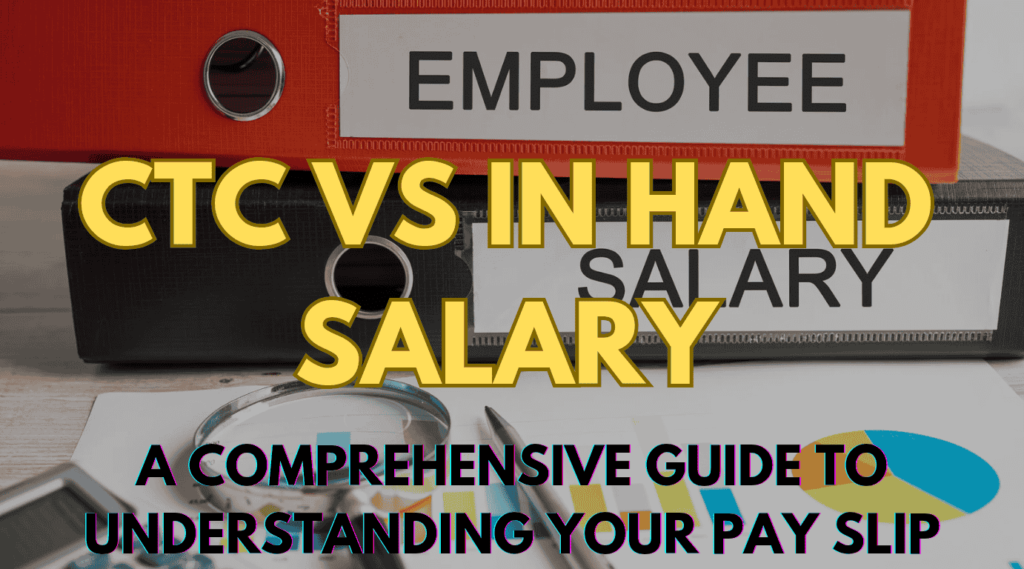CTC vs In-Hand Salary: A Comprehensive Guide to Understanding Your Pay Slip

Quick Overview
Understanding the difference between Cost to Company (CTC) and in-hand salary is crucial for effective financial management. This guide breaks down the components of your pay slip, explaining how each element contributes to your overall earnings and tax obligations. By familiarizing yourself with these components, you can make informed decisions regarding salary negotiations and personal finance management.
Key Points
- Definition of CTC and In-Hand Salary: CTC represents the total cost incurred by the employer for an employee, while in-hand salary is the amount that the employee actually receives after deductions.
- Components of Salary: Key elements include basic salary, House Rent Allowance (HRA), Leave Travel Allowance (LTA), and various allowances that influence net pay.
- Tax Implications: Certain components of salary, like HRA and LTA, can be tax-exempt under specific conditions, impacting overall taxable income.
- Negotiation and Financial Management: Understanding your pay structure aids in salary negotiations and helps manage personal finances effectively.
- Common Deductions: Deductions such as Professional Tax and Employee Provident Fund (EPF) affect the in-hand salary, making awareness of these deductions essential.
Detailed Breakdown
1. Understanding CTC and In-Hand Salary
CTC is the total amount that an employer spends on an employee, which includes not just the salary but also various benefits and allowances. In contrast, in-hand salary refers to the actual amount that employees take home after all deductions. The difference between these two figures can often lead to confusion, especially during salary negotiations.
2. Key Components of Your Pay Slip
Understanding the components of your salary slip is essential to grasp how your earnings are structured. Here are the primary elements:
Basic Salary
- Definition: This is the fixed amount paid to an employee before any allowances or deductions.
- Importance: It serves as the foundation for calculating other benefits, including HRA and Provident Fund contributions.
House Rent Allowance (HRA)
- Purpose: HRA is provided to help employees cover a portion of their rent.
- Tax Benefits: Typically, HRA can be tax-exempt if the employee pays rent, with exemptions ranging from 40% to 50% of the basic salary, depending on company policies and location.
Leave Travel Allowance (LTA)
- Coverage: This allowance covers domestic travel expenses for the employee and their family.
- Claiming: Employees can claim LTA twice in a four-year period, provided they have the necessary travel receipts. This allowance is tax-exempt under specific conditions.
Special Allowance
- Nature: This is a fully taxable allowance often linked to performance, designed to motivate employees based on individual or company performance.
Other Allowances
- Mobile and Internet Allowance: Covers costs incurred for work-related communication. Tax-exempt if bills are in the employee’s name and incurred for official purposes.
- Food Allowance: Provided to cover meal expenses during work hours, typically included in the overall compensation package.
- Conveyance Allowance: Helps cover commuting costs between home and workplace.
3. Deductions from Salary
Understanding deductions is just as important as knowing the components of your salary:
Professional Tax
- Description: A state-specific tax deducted from the salary, varying based on the employee’s location.
Employee Provident Fund (EPF)
- Function: A retirement savings scheme where both the employee and employer contribute 12% of the basic salary.
Tax Deducted at Source (TDS)
- Mechanism: TDS is deducted from the salary based on the applicable income slab, affecting the in-hand salary.
Important Details & Evidence
- Salary Negotiation: Knowing the breakdown of your salary can empower you during negotiations. For instance, if you understand that a large portion of your salary is non-taxable, you may negotiate for a higher CTC while still achieving a desirable in-hand salary.
- Financial Planning: Awareness of tax exemptions related to HRA and LTA can help in reducing taxable income, leading to better financial management.
- Cost of Living Adjustments: Understanding how HRA is calculated based on location can help employees in cities with higher living costs to negotiate better compensation packages.
Final Takeaways
- Know Your Pay Structure: Familiarize yourself with the components of your pay slip to understand how your salary is structured and what affects your in-hand pay.
- Tax Planning: Utilize tax-exempt allowances like HRA and LTA to optimize your taxable income.
- Empower Negotiations: With a clear understanding of your salary components, you can negotiate more effectively, ensuring that you receive a compensation package that reflects your worth.
- Plan for the Future: Consider deductions like EPF as part of your long-term financial planning, ensuring you are prepared for retirement.
By understanding the nuances of your salary structure, you can take control of your financial health, making informed decisions that benefit your present and future.